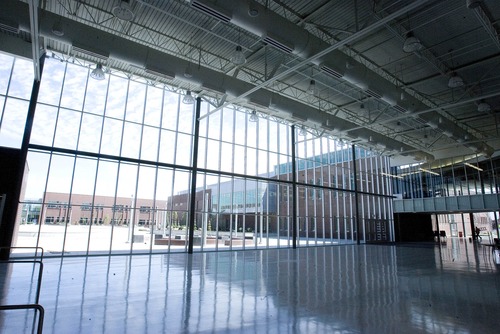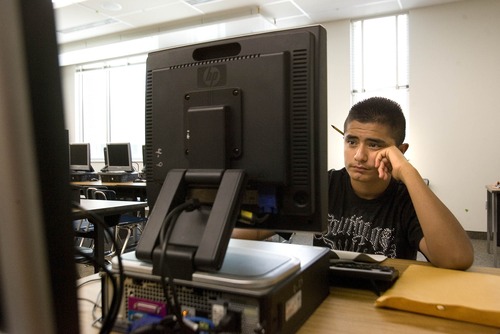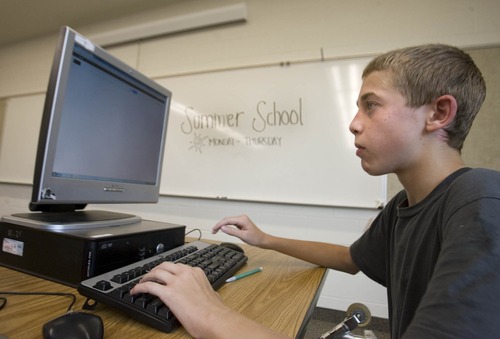This is an archived article that was published on sltrib.com in 2013, and information in the article may be outdated. It is provided only for personal research purposes and may not be reprinted.
School districts in Davis and Washington Counties have virtually eliminated their summer programs. Other Utah school districts are putting off purchases of computers and equipment and have stopped teacher-training programs. Some may lose teacher or aides.
The federal budget slashing of sequestration — along with Utah's shrinking share of the nation's poor — means school districts will have less Title I money this year for teachers, aides and technology.
Generally, Utah districts will see cuts of 7 to 11 percent, said Karl Wilson, director of Title | and federal programs for the Utah Office of Education. The funding gives districts additional money to help low-income children succeed, based on the number of students receiving free or reduced price lunches.
The severity of the cuts depends on the district.
Because low-income children, in particular, often regress academically over the summer, "not having summer school is a big hit," said John Zurbuchen, director of federal/state programs at the Davis School District.
But Granite School District, which gets by far the most Title I money, kept enough in reserves to cushion a 7.3 percent cut — and is expanding its program in an unprecedented way.
Granger High, which will start the school year in a new building, will be the first high school in Utah with a Title I classification. Designated by the district, it will receive $800,000.
"It was becoming a perfect storm," said Granger Principal Jerry Haslam. "All my feeder elementaries and one junior high are Title I. It didn't make a whole lot of sense to say, 'We give extra help all the way up to the high school student and then we're back to normal.'"
—
Coping with cuts • Utah will get $84.9 million in Title I funds for the coming school year, down from $93.2 million last year — a 9 percent cut, according to July 1 projections from the U.S. Department of Education. Final figures won't be known until October.
Congress' mandated "sequestration" cuts in federal spending account for 5.2 percent of the cut. The rest stems from the fact that Utah has a smaller share than other states of students living in poverty, "one of the benefits of Utah not going as deep into the recession and bouncing back sooner," said Wilson at the state office.
Granite received $16.5 million in Title I money last year, leading the state. Next highest was Alpine, Utah's largest district with more than 71,000 students, which got about $8 million.
The $1 million less in Title I money will mean a reduction in new supplies and equipment, and a few aides may not have jobs this year, said Alpine district spokesman John Patten.
Alpine funds programs at 10 Utah County elementary schools and one junior high with its Title I money; the majority are in Orem. No programs will be cut, Patten said.
"It's put us back a few years, but it's not the end of the world," he said.
Washington County School District in southern Utah eliminated summer school at most of its 10 elementaries with Title I funding, and scaled it way back in three others.
It's not yet clear whether schools will lose any staffers, said Title I Director Kathy Peterson. But one technician who helped teachers use technology has already been cut and the elementaries postponed buying computers and software for their second-grade classrooms, she said.
Davis School District, which received nearly $7 million last year, is looking at a cut of about $800,000, and the effects are already evident. Besides cutting out nearly all summer school, Davis is likely to lose 10 to 15 teachers and aides who have been helping to reduce class sizes, Zurbuchen said.
It also cut out the two- or three-day training for teachers that helps them with technology and language instruction. The district has 16 elementaries and one junior high school that receive Title I funds.
Salt Lake City School District expects to lose roughly $1 million of the $7.1 million it got last year for Title I programs. But by moving district money around, securing new grants and, importantly, raising taxes, schools will not have to slash their Title I programs, said Laurie Lacy, Title I director for the district.
The Salt Lake City School Board has approved and plans an Aug. 6 truth-in-taxation hearing on a $3.6 million tax hike, some of which will offset cuts in Title I funding.
The district concentrates its Title I funding in schools with the most poor children, which means some programs come and go. That's what happened to Whittier Elementary, which was edged out for Title I funding this year by another school, Lacy said.
—
'The answer, at least for us.' • At Granger High, the new Title I money will allow Haslam to keep a counselor and seven extra teachers in the language arts, math and sciences.
Like other Utah schools, Granger has received federal school improvement grants funded through Title I, and he hired the staff using that money. But that grant is ending.
Granite watched Congress threaten sequestration last year and purposely kept more Title | money in reserve, said Rob Averett, the district's Title I director. Otherwise, it wouldn't be able to put the additional dollars into Granger.
"We would be cutting things if it were not for that reserve," Averett said.
In the three years Haslam has been at Granger, the high school has reversed its history of never making adequate yearly progress (AYP) under the No Child Left Behind Act, Haslam said.
Granger is beginning to attract students from outside its boundaries, Haslam said, and it is expecting a record number of students this fall, including a new incoming class of more than 700 ninth graders.
"Right now with our testing, we are a normal high school," Haslam said. "Getting more adults in the building is the answer, at least for us."
Twitter: @KristenMoulton









